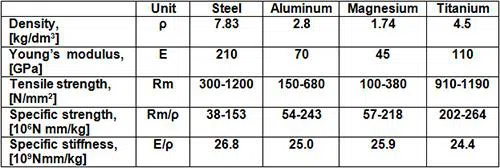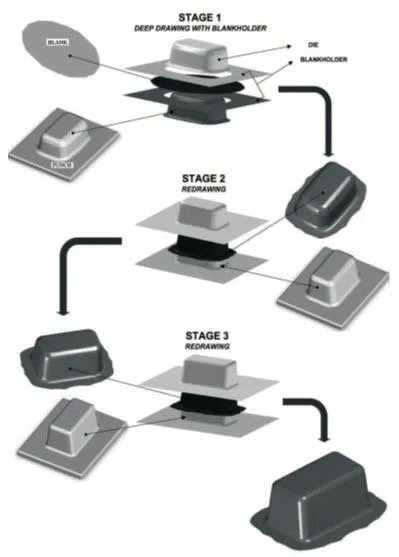Sheet metal forming technologies have been constantly challenged by improvements in the automotive industry over the last several decades. Due to increasing customer expectations, safety requirements and market competition, there is a strong need for products, which can be manufactured more successfully, more economically and swiftly to satisfy these ever-increasing market needs. The outcome of sheet metal forming processes, and especially deep drawing processes are strongly dependent on the materials used.
Deep drawing is the most important process of shaping sheet, where largely deformed metal sheets are turned into the hollow parts. Experimentally, several laboratory methods are utilized to assess the ductility of the sheets. These test methods include cylindrical cup deep drawing and deep shaping operations. In deep drawing sheet metal is draw into a hollow cylindrical shape where the applied forces often are symmetrical. The mechanical properties of the sheet are not often the same in all directions and the crystal anisotropy of sheet materials can be the cause of heterogeneity in the direction of the grain crystallization. Deep-drawn products further require operating margins, which would increase production costs and making thinner products would be helpful to the overall costs. The deep-drawing industry produces metal containers such as pressure or vacuum tanks, some cars and aircraft spare parts, shell and bullet cans and cans for the soft drinks industry.
Some material properties of common metals are given in the Table 1.

Table 1: Material properties of common metallic materials
It can be seen from Table 1 that average steels have high stiffness and strength with a large density, whereas aluminum has moderate- but subjectively good values, making them more popular for deep drawing applications. On the other hand the smaller density and corrosion resistance of aluminum makes it a good candidate for a replacement material for steel.
The design and control of a deep drawing process depends not only on the material, but also on the condition of the tool material interface, the mechanics of plastic deformation, the equipment used, and the control of metal flow. The equipment and tooling parameters that affect the success or failure of a deep drawing operation are the punch, die radii, die clearance, the press speed, the lubrication, the type of restraint to metal flow such as blank holding force (BHF), blank holder gap (BHG), and draw bead. All of these three types of restraints create restraining force by friction between the strip and the tooling.
The use of aluminum (Al) alloys in automotive applications has doubled, mostly due to their high strength to weight ratio and excellent recyclability, which subsequently translate to considerable cost saving. However, since the costs of the Al alloys are higher than those of steels. Further decrease in cost is important so as to expand the usage of these alloys.
To establish the geometry of a part, it is essential to know the limit to which the part material can be formed without reaching failure. This forming limit depends, in addition to the shape change and process conditions, on the ability of a material to deform without failure. The limit drawing ratio (LDR) is commonly used to provide a measure of the drawability of sheet metal.
In the work of Gavaz M., the effect of multi-point blank holder on the LDR of Al-1050 sheets was investigated using (BHG) defined as the fixed distance between the blank holder and the die surface in the stamping process by Weili et al. to promote the deep drawability of aluminum sheets.
A higher LDR and cup height are achieved compared to a normal blank holder when the multi-point blank holder is used. Surface quality is nearly the same compared to normal blank holding systems, however, slight ball-scratch was found on the inner surface of the side wall of the cup. In this method, though the drawing height and LDR are increased, it is not very practical because of placing difficulties of the balls under the blank holder with grease.
This method can be used practically placing the balls to the blank holder tightly with another method that will be investigated, or making the blank holder surface multi-point with different methods without placing the balls. Using a multi-point blank holder may not be the best method to obtain the highest LDR, but it can increase the LDR substantially and can be used for special purposes successfully.
Deep-drawn products are often used for structural elements in the automotive industry. This is why deep drawing is one of the most intensively studied metal forming technologies. Moreover, these products, like for example bodies of cars, are very often important both for the safety considerations and for the visual effect of the final product.
They also considerably influence the weight of the final products, so wherever the technological requirements are met, the producers of deep-drawn parts search for the materials replacing steels, such as aluminum alloys. The use of aluminum alloys is more complicated, not only due to the higher overall costs of aluminum itself, but also due to its properties, making deep drawing of these alloys more difficult.
In recent years, a trend of weight reduction in automobiles is rising from the viewpoint of reducing fuel consumption and exhaust gas emission. Above all, the application of aluminum alloys to automotive body panels is positively considered as a means of effective weight reduction. If aluminum alloy sheets are actually used for automotive body panels, the evaluation of press formability is required in addition to mechanical properties such as strength and ductility.
In sheet steels, it is well known that limiting drawing ratio (LDR) evaluating deep drawability is greatly influenced by the Lankford value expressed by a ratio of true strain in width to true strain in thickness, i.e. r-value (r = dεw/dεt). Similarly, aluminum alloy sheets also seem to show a positive correlation between average r-value and LDR under limited conditions.
Here, when r0, r45 and r90 are r-values at directions of 0°, 45° and 90° to the rolling direction respectively, the average r-value is given by r ̅ = (r0 + 2r45 + r90)/4 conventionally. However, such a correlation has not been clear from experimental results so far, because the average r-value for aluminum alloys produced by conventional rolling and annealing processes generally shows rather lower values than 1 and exists only in a narrow range of 0.55 to 0.85.
The paper of Paćko M. et al. is focused on the multistage deep drawing of AA5754 aluminum alloy box-type part with flange. Both experimental and numerical analysis were performed in this study to predict causes of contraction and cracking occurring in deformed product in respect to the changes of friction conditions on tool-drawn part contact surfaces.
The numerical simulations were performed using eta/DYNAFORM software and LS-DYNA R solver. The research showed, that the results of the simulation are in very good agreement with the results of the real multistage deep drawing processes. Moreover, this study shows, that the proper conditions of friction on the tool-drawpiece contact surface is crucial for the correctness of the analyzed deep drawing process. Too large friction can restrict the material flow, particularly along the edge connecting the bottom and side-walls of the drawpiece, causing wrinkling and cracking.
Figure 4 shows the stages of the modeling performed in this research.

Figure 4: The stages of the modeling of the analyzed deep drawing process
Based on the analysis of multistage deep drawing of a box-type part with flange, made of AA5754 aluminum alloy, the following conclusions can be drawn:
1. The results of the simulation performed using eta/DYNAFORM software are in very good agreement with the results of the real multistage deep drawing processes.
2. Forming-limit diagrams are very important for qualitative analysis of strains at each stage of deep drawing process. In the investigated multi-stage drawing, different areas of the analyzed drawpiece – compared with the results of the numerical simulation combined with forming-limit diagrams – precisely reflect a real behavior of the investigated material in each stage of deformation.
3. The corners of the box-type parts are crucial in respect to the analysis of the investigated deep drawing process. Contraction of the material as well as cracking caused by significant tensile stresses often occurs in these areas of a drawpiece.
4. Proper conditions of friction on the tool-drawpiece contact surface are crucial for the correctness of the analyzed deep drawing process. Too great friction can restrict the material flow, particularly along the edge connecting the bottom and side-walls of the drawpiece, causing wrinkling and cracking.
5. Based on the observations of deep drawing of 5754 aluminum alloy box-type part in industrial conditions it can be stated, that the friction conditions can be improved both by the application of suitable lubricants and proper selection of the areas of the drawpiece to be lubricated. While lubricating the punch, particular attention should be paid to its corners and edges connecting the bottom and side-walls, but also to drawpiece-tools contact surfaces with special emphasis to the areas of side-walls-flange transition. These observations are partly confirmed by the results of the simulations.
6. An increase of drawing force in the consecutive stages of the investigated multistage deep drawing of AA5754 aluminum alloy box-type part can be observed. It is most probably caused by the reduction of the radiuses of the drawpiece corners as well as by the reduction of the radiuses of side surfaces. Moreover, great ability of AA5754 to strain hardening also significantly influences drawing force.




QR Code
